SpringMVC笔记
声明:本文是尚硅谷SpringMVC课程的笔记
1、MVC
(1)MVC是一种软件架构的思想,将软件按照模型、视图、控制器来划分
①M: Model,模型层,指工程中的JavaBean,作用是处理数据 JavaBean分为两类: i.—类称为实体类Bean:专门存储业务数据的,如Student、 User等 ii.—类称为业务处理Bean:指Service或 Dao对象,专门用于处理业务逻辑和数据访问。
②V: View,视图层,指工程中的html或jsp等页面,作用是与用户进行交互,展示数据
③C: Controller,控制层,指工程中的servlet,作用是接收请求和响应浏览器
(2)MVC的工作流程 用户通过视图层发送请求到服务器,在服务器中请求被Controller接收,Controller调用相应的Model层处理请求,处理完毕将结果返回到Controller,Controller再根据请求处理的结果找到相应的View视图,渲染数据后最终响应给浏览器。
2、SpringMVC
SpringMVC是Spring的一个后续产品,是Spring的一 个子项目。 SpringMVC是Spring为表述层开发提供的一整套完备的解决方案。 在表述层框架历经Strust、WebWork、Strust2等诸多产品的历代更迭之后,目前业界普遍选择了SpringMVC作为Java EE项目表述层开发的首选方案。
注: 三层架构分为表述层(或表示层)、业务逻辑层、 数据访问层,表述层表示前台页面和后台servlet
3、SpringMVC特点
(1)Spring 家族原生产品,与IOC容器等基础设施无缝对接。
(2)基于原生的Servlet,通过功能强大的前端控制器DispatcherServlet对请求和响应进行统一处理。
(3)表述层各细分领域需要解决的问题全方位覆盖,提供全面解决方案。
(4)代码清新简洁,大幅度提升开发效率。
(5)内部组件化程度高,可插拔式组件即插即用,想要什么功能配置相应组件即可。
(6)性能卓著,尤其适合现代大型、超大型互联网项目要求。
4、HelloWorld项目
(1)创建Maven工程
①创建


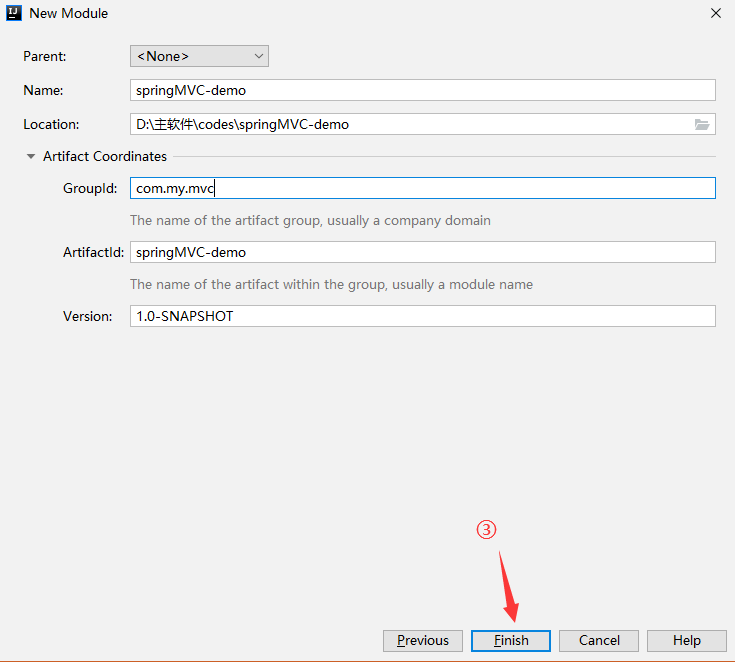
②打包方式:war(pom.xml)
<packaging>war</packaging>
③引入依赖(pom.xml)
<dependencies>
<!-- SpringMVC -->
<dependency>
<groupId>org.springframework</groupId>
<artifactId>spring-webmvc</artifactId>
<version>5.3.1</version>
</dependency>
<!-- 日志 -->
<dependency>
<groupId>ch.qos.logback</groupId>
<artifactId>logback-classic</artifactId>
<version>1.2.3</version>
</dependency>
<!-- ServletAPI -->
<dependency>
<groupId>javax.servlet</groupId>
<artifactId>javax.servlet-api</artifactId>
<version>3.1.0</version>
<scope>provided</scope>
</dependency>
<!-- Spring5和Thymeleaf整合包 -->
<dependency>
<groupId>org.thymeleaf</groupId>
<artifactId>thymeleaf-spring5</artifactId>
<version>3.0.12.RELEASE</version>
</dependency>
</dependencies>
④注意
i.<scope>标签设置依赖范围,即设置什么地方会用到jar包
ii.设置成provided代表已提供,即服务器提供该jar包;当该项目打包为war后,该依赖不会存在于WEB-INF/lib中
iii.由于 Maven 的传递性,我们不必将所有需要的包全部配置依赖,而是配置最顶端的依赖,其他靠传递性导入。
⑤完善web项目的结构
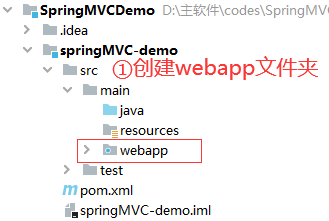


(2)配置web.xml
①默认配置方式
此配置作用下,SpringMVC的配置文件默认位于WEB-INF下,默认名称为<servlet-name>-servlet.xml,例如,以下配置所对应SpringMVC的配置文件位于WEB-INF下,文件名为springMVC-servlet.xml。
<!-- 配置SpringMVC的前端控制器,对浏览器发送的请求统一进行处理 -->
<servlet>
<servlet-name>springMVC</servlet-name>
<servlet-class>org.springframework.web.servlet.DispatcherServlet</servlet-class>
</servlet>
<servlet-mapping>
<servlet-name>springMVC</servlet-name>
<!--
设置springMVC的核心控制器所能处理的请求的请求路径
/所匹配的请求可以是/login或.html或.js或.css方式的请求路径
但是/不能匹配.jsp请求路径的请求
原因:jsp本质是servlet,需要服务器中特殊的指定的servlet来处理
如果jsp请求可以被处理,则DispatcherServlet会将其作为普通的请求来处理,导致无法找到对应的jsp页面
-->
<url-pattern>/</url-pattern>
</servlet-mapping>
<!--
/:不匹配 *.jsp请求
/*:匹配所有请求,包括*.jsp请求
-->
②扩展配置方式
可通过init-param标签设置SpringMVC配置文件的位置和名称,通过load-on-startup标签设置SpringMVC前端控制器DispatcherServlet的初始化时间。
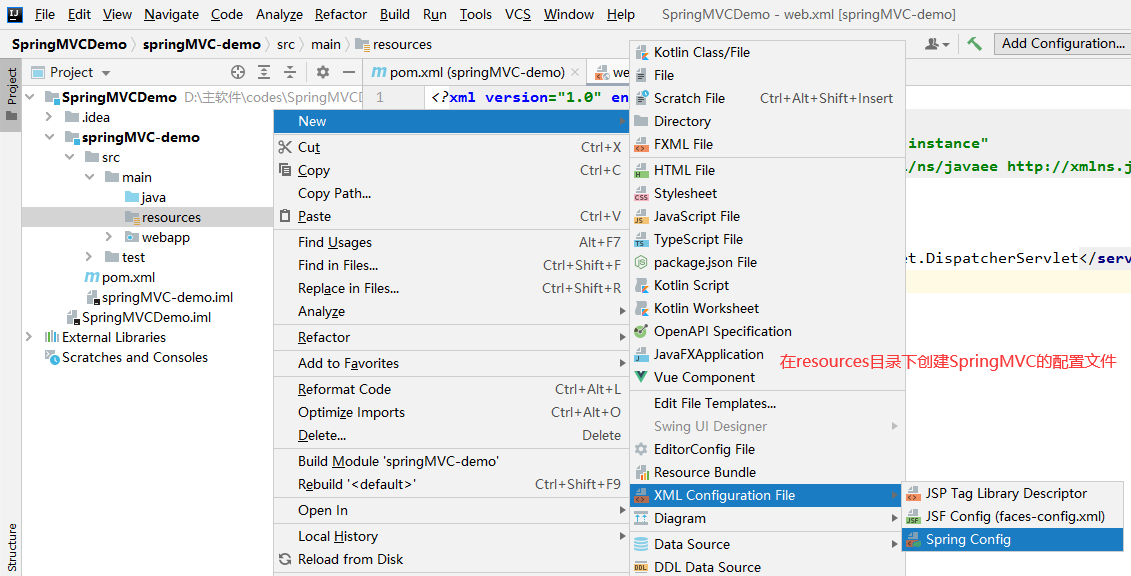
<servlet>
<servlet-name>springMVC</servlet-name>
<servlet-class>org.springframework.web.servlet.DispatcherServlet</servlet-class>
<!-- 通过初始化参数指定SpringMVC配置文件的位置和名称 -->
<init-param>
<!-- contextConfigLocation为固定值 -->
<param-name>contextConfigLocation</param-name>
<!-- 使用classpath:表示从类路径查找配置文件,例如maven工程中的src/main/resources -->
<param-value>classpath:springMVC.xml</param-value>
</init-param>
<!--
作为框架的核心组件,在启动过程中有大量的初始化操作要做
而这些操作放在第一次请求时才执行会严重影响访问速度
因此需要通过此标签将启动控制DispatcherServlet的初始化时间提前到服务器启动时
-->
<load-on-startup>1</load-on-startup>
</servlet>
<servlet-mapping>
<servlet-name>springMVC</servlet-name>
<url-pattern>/</url-pattern>
</servlet-mapping>
(3)创建请求控制器
由于前端控制器对浏览器发送的请求进行了统一的处理,但是具体的请求有不同的处理过程,因此需要创建处理具体请求的类,即请求控制器。
因为SpringMVC的控制器由一个POJO(普通的Java类)担任,因此需要通过@Controller注解将其标识为一个控制层组件,交给Spring的IoC容器管理,此时SpringMVC才能够识别控制器的存在。
1 @Controller
2 public class HelloController {}
(4)配置SpringMVC的配置文件(springMVC.xml)
<!-- 自动扫描包 -->
<context:component-scan base-package="com.atguigu.mvc.controller"/>
<!-- 配置Thymeleaf视图解析器 -->
<bean id="viewResolver" class="org.thymeleaf.spring5.view.ThymeleafViewResolver">
<property name="order" value="1"/> <!-- 配置优先级 -->
<property name="characterEncoding" value="UTF-8"/>
<property name="templateEngine"> <!-- 模板 -->
<bean class="org.thymeleaf.spring5.SpringTemplateEngine"> <!-- 内部bean -->
<property name="templateResolver">
<bean class="org.thymeleaf.spring5.templateresolver.SpringResourceTemplateResolver">
<!-- 视图前缀 -->
<property name="prefix" value="/WEB-INF/templates/"/>
<!-- 视图后缀 -->
<property name="suffix" value=".html"/>
<property name="templateMode" value="HTML5"/> <!-- 模板模型 -->
<property name="characterEncoding" value="UTF-8" />
</bean>
</property>
</bean>
</property>
</bean>
<!-- WEB-INF目录下的页面无法直接访问,需要通过视图解析器解析 -->
(5)配置tomcat


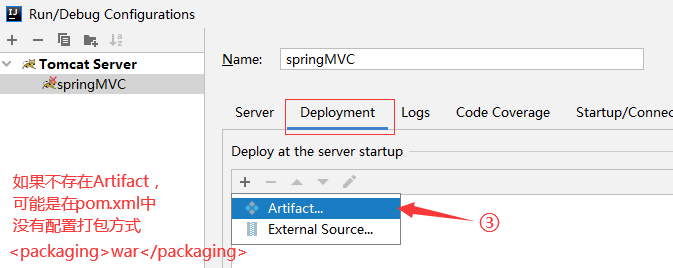

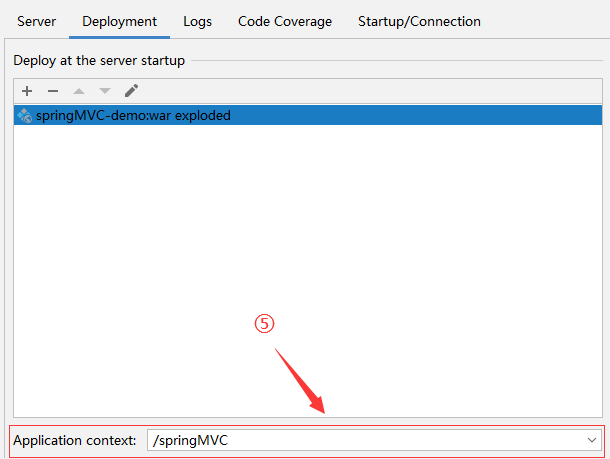
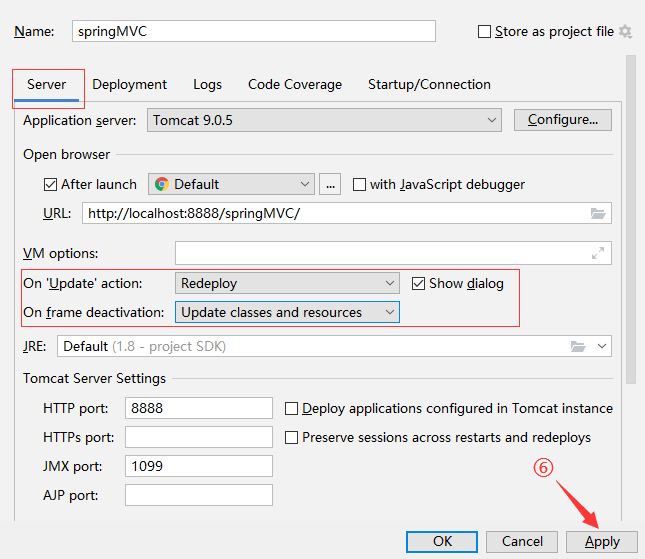
(6)编写HTML页面
<!-- index.html,文件存放于WEB-INF/templates目录下-->
<!DOCTYPE html>
<html lang="en" xmlns:th="http://www.thymeleaf.org">
<head>
<meta charset="UTF-8">
<title>首页</title>
</head>
<body>
<h1>首页</h1>
<a th:href="@{/hello}">HelloWorld</a><br/>
</body>
</html>
<!-- target.html -->
<!DOCTYPE html>
<html lang="en" xmlns:th="http://www.thymeleaf.org">
<head>
<meta charset="UTF-8">
<title>target</title>
</head>
<body>
hello,world!
</body>
</html>
(7)在请求控制器中创建处理请求的方法
// @RequestMapping注解:处理请求和控制器方法之间的映射关系
// @RequestMapping注解的value属性可以通过请求地址匹配请求,/表示的当前工程的上下文路径
// localhost:8080/springMVC/
@RequestMapping("/")
public String index() {
//设置视图名称
return "index";
}
@RequestMapping("/target")
public String HelloWorld() {
return "target";
}
(8)总结
浏览器发送请求,若请求地址符合前端控制器的url-pattern,该请求就会被前端控制器DispatcherServlet处理。前端控制器会读取SpringMVC的核心配置文件,通过扫描组件找到控制器,将请求地址和控制器中@RequestMapping注解的value属性值进行匹配,若匹配成功,该注解所标识的控制器方法就是处理请求的方法。处理请求的方法需要返回一个字符串类型的视图名称,该视图名称会被视图解析器解析,加上前缀和后缀组成视图的路径,通过Thymeleaf对视图进行渲染,最终转发到视图所对应页面。
5、@RequestMapping注解
(1)功能
@RequestMapping注解的作用就是将请求和处理请求的控制器方法关联起来,建立映射关系。
(2)注解的位置
@RequestMapping标识一个类:设置映射请求的请求路径的初始信息
@RequestMapping标识一个方法:设置映射请求请求路径的具体信息
@Controller
@RequestMapping("ReqMap")
public class RequestMappingController {
////此时请求映射所映射的请求的请求路径为:/ReqMap/success
@RequestMapping("success")
public String success(){
return "success";
}
}
(3)注解的value属性
@RequestMapping注解的value属性通过请求的请求地址匹配请求映射。
@RequestMapping注解的value属性是一个字符串类型的数组,表示该请求映射能够匹配多个请求地址所对应的请求。
@RequestMapping注解的value属性必须设置,至少通过请求地址匹配请求映射。
<!--html页面,都可以跳转到success.html页面-->
<a th:href="@{/ReqMap/success}">测试@RequestMapping的value值-->success</a><br/>
<a th:href="@{/ReqMap/tests}">测试@RequestMapping的value值-->tests</a><br/>
1 @RequestMapping(
2 value = {"success","tests"}
3 )
4 public String success(){
5 return "success";
6 }
(4)注解的method属性
@RequestMapping注解的method属性通过请求的请求方式(get或post)匹配请求映射。不设置代表任何请求方式都可以。
@RequestMapping注解的method属性是一个RequestMethod类型的数组,表示该请求映射能够匹配多种请求方式的请求。
若当前请求的请求地址满足请求映射的value属性,但是请求方式不满足method属性,则浏览器报错405:Request method 'POST' not supported。
<a th:href="@{/ReqMap/tests}">测试@RequestMapping的method属性-->get</a><br/>
<form th:action="@{/ReqMap/tests}" method="post"><input type="submit" value="测试@RequestMapping的method属性-->post"></form>
1 @RequestMapping(
2 value = {"success","tests"},
3 method = {RequestMethod.GET}
4 )
5 public String success(){
6 return "success";
7 }
注意:
1、对于处理指定请求方式的控制器方法,SpringMVC中提供了@RequestMapping的派生注解
处理get请求的映射-->@GetMapping
处理post请求的映射-->@PostMapping
处理put请求的映射-->@PutMapping
处理delete请求的映射-->@DeleteMapping
2、常用的请求方式有get,post,put,delete
但是目前浏览器只支持get和post,若在form表单提交时,为method设置了其他请求方式的字符串(put或delete),则按照默认的请求方式get处理
若要发送put和delete请求,则需要通过spring提供的过滤器HiddenHttpMethodFilter,在RESTful部分会讲到
(5)注解的params属性
@RequestMapping注解的params属性通过请求的请求参数匹配请求映射。
@RequestMapping注解的params属性是一个字符串类型的数组,可以通过四种表达式设置请求参数和请求映射的匹配关系。
1 //要求请求映射所匹配的请求必须携带username请求参数
2 params = {"username"}
3 //要求请求映射所匹配的请求必须不能携带username请求参数
4 params = {"!username"}
5 //要求请求映射所匹配的请求必须携带username请求参数且username=admin
6 params = {"username=admin"}
7 //要求请求映射所匹配的请求必须携带username请求参数但是username!=admin
8 params = {"username!=admin"}
<a th:href="@{/testParams(username='admin',password=12345678)}">测试@RequestMapping的params属性</a><br/>
1 @RequestMapping(
2 value = "/testParams",
3 params = {"username","password"}
4 )
5 public String testParams(){
6 return "success";
7 }
注意:
若当前请求满足@RequestMapping注解的value和method属性,但是不满足params属性,此时页面回报错400:Parameter conditions "username, password!=123456" not met for actual request parameters: username={admin}, password={123456}
(6)注解的headers属性
@RequestMapping注解的headers属性通过请求的请求头信息匹配请求映射。
@RequestMapping注解的headers属性是一个字符串类型的数组,可以通过四种表达式设置请求头信息和请求映射的匹配关系。
<a th:href="@{/testHeaders}">测试@RequestMapping的headers属性</a><br/>
1 @RequestMapping(
2 value = "/testHeaders",
3 headers = {"Host=localhost:8888"}
4 )
5 public String testHeaders(){
6 return "success";
7 }
注意:
若当前请求满足@RequestMapping注解的value和method属性,但是不满足headers属性,此时页面显示404错误,即资源未找到
(7)SpringMVC支持ant风格的路径
①?:表示任意的单个字符
②*:表示任意的0个或多个字符
③**:表示任意的一层或多层目录
<a th:href="@{/a2a/testAnt}">测试@RequestMapping的ant风格路径-->使用?</a><br/>
<a th:href="@{/aa/testAnt2}">测试@RequestMapping的ant风格路径-->使用*</a><br/>
<a th:href="@{/a/a/testAnt3}">测试@RequestMapping的ant风格路径-->使用**</a><br/>
1 @RequestMapping("/a?a/testAnt")
2 public String testAnt(){ return "success"; }
3
4 @RequestMapping("/a*a/testAnt2")
5 public String testAnt2(){ return "success"; }
6
7 @RequestMapping("/**/testAnt3")
8 public String testAnt3(){ return "success"; }
注意:
在使用**时,只能使用/**/xxx的方式
如果写成/a**a/xxx,其中的 * *会被处理成两个单个的 *
(8)SpringMVC支持路径中的占位符
原始方式:/deleteUser?id=1
rest方式:/deleteUser/1
SpringMVC路径中的占位符常用于RESTful风格中,当请求路径中将某些数据通过路径的方式传输到服务器中,就可以在相应的@RequestMapping注解的value属性中通过占位符{xxx}表示传输的数据,在通过@PathVariable注解,将占位符所表示的数据赋值给控制器方法的形参。
<a th:href="@{/testPath/admin/18}">测试@RequestMapping的路径中的占位符</a><br/>
1 @RequestMapping("/testPath/{username}/{age}")
2 public String testPath(@PathVariable("username") String username,@PathVariable("age") Integer age){
3 System.out.println("username:" + username + ";age:" + age);
4 return "success";
5 }
注意:
当有占位符时,路径中必须有所体现。例如上面的例子,不能写成/testPath/admin,会产生404错误
6、SpringMVC获取请求参数
(1)通过ServletAPI获取
将HttpServletRequest作为控制器方法的形参,此时HttpServletRequest类型的参数表示封装了当前请求的请求报文的对象。不推荐使用这种方式来获取参数。
<a th:href="@{/testServletAPI(username='admin',password=123456)}">测试ServletAPI</a>
1 @RequestMapping("/testServletAPI")
2 public String testServletAPI(HttpServletRequest request){
3 String username = request.getParameter("username");
4 String password = request.getParameter("password");
5 System.out.println("username:" + username + ";password:" + password);
6 return "success";
7 }
(2)通过控制器方法的形参获取请求参数
在控制器方法的形参位置,设置和请求参数同名的形参,当浏览器发送请求,匹配到请求映射时,在DispatcherServlet中就会将请求参数赋值给相应的形参。
<form th:action="@{/testParam}" method="post">
用户名:<input type="text" name="username"/><br/>
密码:<input type="password" name="password"/><br/>
爱好:<input type="checkbox" name="hobby" value="a">a
<input type="checkbox" name="hobby" value="b">b
<input type="checkbox" name="hobby" value="c">c<br/>
<input type="submit" value="测试通过控制器方法的形参获取请求参数"/>
</form>
1 @RequestMapping("/testParam")
2 public String testParams(String username,String password,String[] hobby){
3 System.out.println("username:" + username + ";password:" + password + ";hobby:" + Arrays.toString(hobby));
4 return "success";
5 }
6 /*输出结果:
7 username:admin;password:123456;hobby:[a, b, c]
8 */
注意:
若请求所传输的请求参数中有多个同名的请求参数,此时可以在控制器方法的形参中设置字符串数组或者字符串类型的形参接收此请求参数
若使用字符串数组类型的形参,此参数的数组中包含了每一个数据
若使用字符串类型的形参,此参数的值为每个数据中间使用逗号拼接的结果
(3)@RequestParam
@RequestParam是将请求参数和控制器方法的形参创建映射关系。
@RequestParam注解一共有三个属性:
①value:指定为形参赋值的请求参数的参数名
②required:设置是否必须传输此请求参数,默认值为true
③defaultValue:不管required属性值为true或false,当value所指定的请求参数没有传输或传输的值为""时,则使用默认值为形参赋值
required若设置为true时,则当前请求必须传输value所指定的请求参数,若没有传输该请求参数,且没有设置defaultValue属性,则页面报错400:Required String parameter 'xxx' is not present;若设置为false,则当前请求不是必须传输value所指定的请求参数,若没有传输,则注解所标识的形参的值为null
<!--username:yq;password:123456-->
<a th:href="@{/testRequestParam(password=123456)}">测试RequestParam</a><br/>
<!--username:admin;password:123-->
<a th:href="@{/testRequestParam(user_name='admin',password='')}">测试RequestParam2</a><br/>
<!--username:admin;password:123-->
<a th:href="@{/testRequestParam(user_name='admin')}">测试RequestParam3</a><br/>
1 @RequestMapping("/testRequestParam")
2 public String testRequestParam(
3 @RequestParam(value = "user_name",required = false,defaultValue = "yq") String username,
4 @RequestParam(defaultValue = "123") String password
5 ){
6 System.out.println("username:" + username + ";password:" + password);
7 return "success";
8 }
(4)@RequestHeader
@RequestHeader是将请求头信息和控制器方法的形参创建映射关系。
@RequestHeader注解一共有三个属性:value、required、defaultValue,用法同@RequestParam。
注意:
若要在控制器中获取头信息必须使用@RequestHeader注解
(5)@CookieValue
@CookieValue是将cookie数据和控制器方法的形参创建映射关系。
@CookieValue注解一共有三个属性:value、required、defaultValue,用法同@RequestParam。
(6)通过POJO获取请求参数
可以在控制器方法的形参位置设置一个实体类类型的形参,此时若浏览器传输的请求参数的参数名和实体类中的属性名一致,那么请求参数就会为此属性赋值。
<form th:action="@{/testBean}" method="post">
用户名:<input type="text" name="username"><br>
密码:<input type="password" name="password"><br>
性别:<input type="radio" name="sex" value="男">男<input type="radio" name="sex" value="女">女<br>
<input type="submit">
</form>
@RequestMapping("/testBean")
public String testBean(User user){
System.out.println(user);
return "success";
}
//User{username='admin', password='123456', sex='男'}
(7)解决获取请求参数的乱码问题
解决获取请求参数的乱码问题,可以使用SpringMVC提供的编码过滤器CharacterEncodingFilter,但是必须在web.xml中进行注册。
<!--配置springMVC的编码过滤器-->
<filter>
<filter-name>CharacterEncodingFilter</filter-name>
<filter-class>org.springframework.web.filter.CharacterEncodingFilter</filter-class>
<init-param>
<param-name>encoding</param-name>
<param-value>UTF-8</param-value>
</init-param>
<init-param>
<param-name>forceResponseEncoding</param-name>
<param-value>true</param-value>
</init-param>
</filter>
<filter-mapping>
<filter-name>CharacterEncodingFilter</filter-name>
<url-pattern>/*</url-pattern>
</filter-mapping>
注意:
SpringMVC中处理编码的过滤器一定要配置到其他过滤器之前,否则无效
7、域对象共享数据
(1)使用ServletAPI向request域对象共享数据
<p th:text="${testRequestByServletAPI}"></p>
1 @RequestMapping("/testRequestByServletAPI")
2 public String testRequestByServletAPI(HttpServletRequest request){
3 request.setAttribute("testRequestByServletAPI","hello");
4 return "success";
5 }
(2)使用ModelAndView向request域对象共享数据
<p th:text="${testRequestScope}"></p>
1 @RequestMapping("/testModelAndView")
2 public ModelAndView testModelAndView(){
3 /**
4 * ModelAndView有Model和View的功能
5 * Model主要用于向请求域共享数据
6 * View主要用于设置视图,实现页面跳转
7 */
8 ModelAndView mav = new ModelAndView();
9 //向请求域共享数据
10 mav.addObject("testScope", "hello,ModelAndView");
11 //设置视图,实现页面跳转
12 mav.setViewName("success");
13 return mav;
14 }
(3)使用Model向request域对象共享数据
1 @RequestMapping("/testModel")
2 public String testModel(Model model){
3 model.addAttribute("testRequestScope","hello,Model");
4 return "success";
5 }
(4)使用map向request域对象共享数据
1 @RequestMapping("/testMap")
2 public String testMap(Map<String,Object> map){
3 map.put("testRequestScope","hello,Map");
4 return "success";
5 }
(5)使用ModelMap向request域对象共享数据
1 @RequestMapping("/testModelMap")
2 public String testModelMap(ModelMap modelMap){
3 modelMap.addAttribute("testRequestScope","hello,ModelMap");
4 return "success";
5 }
(6)Model、ModelMap、Map的关系
Model、ModelMap、Map类型的参数其实本质上都是 BindingAwareModelMap 类型的。最终都会封装进ModelAndView。
1 public interface Model{}
2 public class ModelMap extends LinkedHashMap<String, Object> {}
3 public class ExtendedModelMap extends ModelMap implements Model {}
4 public class BindingAwareModelMap extends ExtendedModelMap {}
(7)向session域共享数据
1 @RequestMapping("/testSession")
2 public String testSession(HttpSession session){
3 session.setAttribute("testSessionScope","hello,session");
4 return "success";
5 }
(8)向application域共享数据
1 @RequestMapping("/testApplication")
2 public String testApplication(HttpSession session){
3 ServletContext application = session.getServletContext();
4 application.setAttribute("testApplicationScope","hello,Application");
5 return "success";
6 }
8、SpringMVC的视图
SpringMVC中的视图是View接口,视图的作用渲染数据,将模型Model中的数据展示给用户。
SpringMVC视图的种类很多,默认有转发视图和重定向视图。
当工程引入jstl的依赖,转发视图会自动转换为JstlView。
若使用的视图技术为Thymeleaf,在SpringMVC的配置文件中配置了Thymeleaf的视图解析器,由此视图解析器解析之后所得到的是ThymeleafView。
(1)ThymeleafView
当控制器方法中所设置的视图名称没有任何前缀时,此时的视图名称会被SpringMVC配置文件中所配置的视图解析器解析,视图名称拼接视图前缀和视图后缀所得到的最终路径,会通过转发的方式实现跳转。
1 @RequestMapping("/testThymeleafView")
2 public String testThymeleafView(){
3 return "success";
4 }


(2)转发视图
SpringMVC中默认的转发视图是InternalResourceView。
SpringMVC中创建转发视图的情况:
当控制器方法中所设置的视图名称以"forward:"为前缀时,创建InternalResourceView视图,此时的视图名称不会被SpringMVC配置文件中所配置的视图解析器解析,而是会将前缀"forward:"去掉,剩余部分作为最终路径通过转发的方式实现跳转。
1 @RequestMapping("/testForward")
2 public String testForward(){
3 return "forward:/testThymeleafView";
4 }
5 //会创建两次视图,第一次是InternalResourceView,第二次是ThymeleafView


(3)重定向视图
SpringMVC中默认的重定向视图是RedirectView。
当控制器方法中所设置的视图名称以"redirect:"为前缀时,创建RedirectView视图,此时的视图名称不会被SpringMVC配置文件中所配置的视图解析器解析,而是会将前缀"redirect:"去掉,剩余部分作为最终路径通过重定向的方式实现跳转。
1 @RequestMapping("/testRedirect")
2 public String testRedirect(){
3 return "redirect:/testThymeleafView";
4 }


注意:
重定向视图在解析时,会先将redirect:前缀去掉,然后会判断剩余部分是否以/开头,若是则会自动拼接上下文路径
(4)视图控制器view-controller
当控制器方法中,仅仅用来实现页面跳转,即只需要设置视图名称时,可以将处理器方法使用view-controller标签进行表示。
<!--
path:设置处理的请求地址
view-name:设置请求地址所对应的视图名称
-->
<mvc:view-controller path="/" view-name="index"></mvc:view-controller>
注意:
当SpringMVC中设置任何一个view-controller时,其他控制器中的请求映射将全部失效,此时需要在SpringMVC的核心配置文件中设置开启mvc注解驱动的标签:
<mvc:annotation-driven />
(5)SpringMVC访问JSP页面
①配置springMVC.xml
<!--开启组件扫描-->
<context:component-scan base-package="com.my.mvc.controller"></context:component-scan>
<!--视图解析器-->
<bean class="org.springframework.web.servlet.view.InternalResourceViewResolver">
<property name="prefix" value="/WEB-INF/templates/"></property>
<property name="suffix" value=".jsp"></property>
</bean>
②控制器
1 @Controller
2 public class JSPController {
3 @RequestMapping("/success")
4 public String success(){
5 return "success";
6 }
7 }
③jsp页面
<a href="${pageContext.request.contextPath}/success">success.jsp</a>
9、RESTful
(1)RESTful简介
REST:Representational State Transfer,表现层资源状态转移。
①资源
资源是一种看待服务器的方式,即,将服务器看作是由很多离散的资源组成。每个资源是服务器上一个可命名的抽象概念。与面向对象设计类似,资源是以名词为核心来组织的,首先关注的是名词。一个资源可以由一个或多个URI来标识。URI既是资源的名称,也是资源在Web上的地址。对某个资源感兴趣的客户端应用,可以通过资源的URI与其进行交互。
②资源的表述
资源的表述是一段对于资源在某个特定时刻的状态的描述。可以在客户端-服务器端之间转移(交换)。资源的表述可以有多种格式,例如HTML/XML/JSON/纯文本/图片/视频/音频等等。资源的表述格式可以通过协商机制来确定。请求-响应方向的表述通常使用不同的格式。
③状态转移
状态转移说的是:在客户端和服务器端之间转移(transfer)代表资源状态的表述。通过转移和操作资源的表述,来间接实现操作资源的目的。
(2)RESTful的实现
具体说,就是 HTTP 协议里面,四个表示操作方式的动词:GET、POST、PUT、DELETE。
它们分别对应四种基本操作:GET 用来获取资源,POST 用来新建资源,PUT 用来更新资源,DELETE 用来删除资源。
REST 风格提倡 URL 地址使用统一的风格设计,从前到后各个单词使用斜杠分开,不使用问号键值对方式携带请求参数,而是将要发送给服务器的数据作为 URL 地址的一部分,以保证整体风格的一致性。
| 操作 | 传统方式 | REST风格 |
|---|---|---|
| 查询操作 | getUserById?id=1 | user/1-->get请求方式 |
| 保存操作 | saveUser | user-->post请求方式 |
| 删除操作 | deleteUser?id=1 | user/1-->delete请求方式 |
| 更新操作 | updateUser | user-->put请求方式 |
(3)HiddenHttpMethodFilter
由于浏览器只支持发送get和post方式的请求,那么该如何发送put和delete请求呢?
SpringMVC 提供了 HiddenHttpMethodFilter 帮助我们将 POST 请求转换为 DELETE 或 PUT 请求。
HiddenHttpMethodFilter 处理put和delete请求的条件:
①当前请求的请求方式必须为post
②当前请求必须传输请求参数_method
满足以上条件,HiddenHttpMethodFilter 过滤器就会将当前请求的请求方式转换为请求参数_method的值,因此请求参数_method的值才是最终的请求方式。
<!--配置HiddenHttpMethodFilter-->
<filter>
<filter-name>HiddenHttpMethodFilter</filter-name>
<filter-class>org.springframework.web.filter.HiddenHttpMethodFilter</filter-class>
</filter>
<filter-mapping>
<filter-name>HiddenHttpMethodFilter</filter-name>
<url-pattern>/*</url-pattern>
</filter-mapping>
注意:
目前为止,SpringMVC中提供了两个过滤器:CharacterEncodingFilter和HiddenHttpMethodFilter。
在web.xml中注册时,必须先注册CharacterEncodingFilter,再注册HiddenHttpMethodFilter。
原因:
在 CharacterEncodingFilter 中通过 request.setCharacterEncoding(encoding) 方法设置字符集的
request.setCharacterEncoding(encoding) 方法要求前面不能有任何获取请求参数的操作
而 HiddenHttpMethodFilter 恰恰有一个获取请求方式的操作:
String paramValue = request.getParameter(this.methodParam);
10、RESTful案例
(1)准备工作
和传统 CRUD 一样,实现对员工信息的增删改查。
①搭建环境
②准备实体类
1 package com.my.mvc.bean; 2 3 public class Employee { 4 private Integer id; 5 private String name; 6 private Integer gender;//1 male, 0 female 7 private String position; 8 9 public Employee() { 10 } 11 12 public Employee(Integer id, String name, Integer gender, String position) { 13 this.id = id; 14 this.name = name; 15 this.gender = gender; 16 this.position = position; 17 } 18 19 public Integer getId() { 20 return id; 21 } 22 23 public void setId(Integer id) { 24 this.id = id; 25 } 26 27 public String getName() { 28 return name; 29 } 30 31 public void setName(String name) { 32 this.name = name; 33 } 34 35 public Integer getGender() { 36 return gender; 37 } 38 39 public void setGender(Integer gender) { 40 this.gender = gender; 41 } 42 43 public String getPosition() { 44 return position; 45 } 46 47 public void setPosition(String position) { 48 this.position = position; 49 } 50 51 @Override 52 public String toString() { 53 return "Employee{" + 54 "id=" + id + 55 ", name='" + name + '\'' + 56 ", gender=" + gender + 57 ", position='" + position + '\'' + 58 '}'; 59 } 60 }
③准备dao类模拟数据
1 package com.my.mvc.dao;
2
3 @Repository
4 public class EmployeeDao {
5 private static Map<Integer, Employee> employees = null;
6 static {
7 employees = new HashMap<Integer, Employee>();
8 employees.put(1001,new Employee(1001,"zhang",1,"总经理"));
9 employees.put(1002,new Employee(1002,"yu",1,"副总经理"));
10 employees.put(1003,new Employee(1003,"wang",1,"主管"));
11 }
12
13 private static Integer initId = 1004;
14 //保存,存在id是更新,不存在id是添加
15 public void save(Employee employee){
16 if(employee.getId() == null){
17 employee.setId(initId++);
18 }
19 employees.put(employee.getId(), employee);
20 }
21 public Collection<Employee> getAll(){
22 return employees.values();
23 }
24
25 public Employee get(Integer id){
26 return employees.get(id);
27 }
28
29 public void delete(Integer id){
30 employees.remove(id);
31 }
32 }
(2)功能清单
| 功能 | URL 地址 | 请求方式 |
|---|---|---|
| 访问首页√ | / | GET |
| 查询全部数据√ | /employee | GET |
| 删除√ | /employee/2 | DELETE |
| 跳转到添加数据页面√ | /toAdd | GET |
| 执行保存√ | /employee | POST |
| 跳转到更新数据页面√ | /employee/2 | GET |
| 执行更新√ | /employee | PUT |
(3)具体功能:访问首页
①配置view-controller
<mvc:view-controller path="/" view-name="index"/>
②创建页面
<!DOCTYPE html>
<html lang="en" xmlns:th="http://www.thymeleaf.org">
<head>
<meta charset="UTF-8" >
<title>首页</title>
</head>
<body>
<h1>首页</h1>
<a th:href="@{/employee}">访问员工信息</a>
</body>
</html>
(4)具体功能:查询全部数据
①控制器方法
1 @RequestMapping(value = "/employee",method = RequestMethod.GET)
2 public String getAllEmployees(Model model){
3 Collection<Employee> employeeList = employeeDao.getAll();
4 model.addAttribute("employeeList",employeeList);
5 return "employee_list";
6 }
②创建employee_list.html
<!DOCTYPE html>
<html lang="en" xmlns:th="http://www.thymeleaf.org">
<head>
<meta charset="UTF-8">
<title>员工信息列表</title>
<script type="text/javascript" th:src="@{/static/js/vue.js}"></script>
</head>
<body>
<table border="1" cellpadding="0" cellspacing="0" style="text-align: center;" id="dataTable">
<tr>
<th colspan="5">Employee Info</th>
</tr>
<tr>
<th>id</th>
<th>lastName</th>
<th>email</th>
<th>gender</th>
<th>options(<a th:href="@{/toAdd}">add</a>)</th>
</tr>
<tr th:each="employee : ${employeeList}">
<td th:text="${employee.id}"></td>
<td th:text="${employee.name}"></td>
<td th:text="${employee.gender}"></td>
<td th:text="${employee.position}"></td>
<td>
<a class="deleteA" @click="deleteEmployee" th:href="@{'/employee/'+${employee.id}}">delete</a>
<a th:href="@{'/employee/'+${employee.id}}">update</a>
</td>
</tr>
</table>
</body>
</html>
(5)具体功能:删除
①创建处理delete请求方式的表单
<!-- 作用:通过超链接控制表单的提交,将post请求转换为delete请求 -->
<form id="delete_form" method="post">
<!-- HiddenHttpMethodFilter要求:必须传输_method请求参数,并且值为最终的请求方式 -->
<input type="hidden" name="_method" value="delete"/>
</form>
②删除超链接绑定点击事件
i.引入vue.js
<script type="text/javascript" th:src="@{/static/js/vue.js}"></script>
ii.删除超链接
<!--th:href="@{/employee/}+${employee.id}"-->
<a class="deleteA" @click="deleteEmployee" th:href="@{'/employee/'+${employee.id}}">delete</a>
iii.通过vue处理点击事件
<script type="text/javascript">
var vue = new Vue({
el:"#dataTable",
methods:{
//event表示当前事件
deleteEmployee:function (event) {
//通过id获取表单标签
var delete_form = document.getElementById("delete_form");
//将触发事件的超链接的href属性为表单的action属性赋值
delete_form.action = event.target.href;
//提交表单
delete_form.submit();
//阻止超链接的默认跳转行为
event.preventDefault();
}
}
});
</script>
③控制器方法
1 @RequestMapping(value = "/employee/{id}",method = RequestMethod.DELETE)
2 public String deleteEmployee(@PathVariable("id") Integer id){
3 employeeDao.delete(id);
4 return "redirect:/employee";
5 }
(6)具体功能:跳转到添加数据页面
①配置view-controller
<mvc:view-controller path="/toAdd" view-name="employee_add"></mvc:view-controller>
②创建employee_add.html
<!DOCTYPE html>
<html lang="en" xmlns:th="http://www.thymeleaf.org">
<head>
<meta charset="UTF-8">
<title>添加员工信息</title>
</head>
<body>
<form th:action="@{/employee}" method="post">
name:<input type="text" name="name"><br>
position:<input type="text" name="position"><br>
gender:<input type="radio" name="gender" value="1">male
<input type="radio" name="gender" value="0">female<br>
<input type="submit" value="add"><br>
</form>
</body>
</html>
(7)具体功能:执行保存
①控制器方法
1 @RequestMapping(value = "/employee",method = RequestMethod.POST)
2 public String addEmployee(Employee employee){
3 employeeDao.save(employee);
4 return "redirect:/employee";
5 }
(8)具体功能:跳转到具体页面
①修改超链接
<a th:href="@{'/employee/'+${employee.id}}">update</a>
②控制器方法
1 @RequestMapping(value = "/employee/{id}",method = RequestMethod.GET)
2 public String getEmployee(@PathVariable("id") Integer id,Model model){
3 Employee employee = employeeDao.get(id);
4 model.addAttribute("employee",employee);
5 return "/employee_update";
6 }
③创建employee_update.html
<!DOCTYPE html>
<html lang="en" xmlns:th="http://www.thymeleaf.org">
<head>
<meta charset="UTF-8">
<title>更新员工信息</title>
</head>
<body>
<form th:action="@{/employee}" method="post">
<input type="hidden" name="_method" value="PUT">
<input type="hidden" name="id" th:value="${employee.id}">
name:<input type="text" name="name" th:value="${employee.name}"><br>
position:<input type="text" name="position" th:value="${employee.position}"><br>
gender:<input type="radio" name="gender" value="1" th:field="${employee.gender}">male
<input type="radio" name="gender" value="0" th:field="${employee.gender}">female<br>
<input type="submit" value="update"><br>
</form>
</body>
</html>
(9)具体功能:执行更新
①控制器方法
1 @RequestMapping(value = "/employee",method = RequestMethod.PUT)
2 public String updateEmployee(Employee employee){
3 employeeDao.save(employee);
4 return "redirect:/employee";
5 }
(10)处理静态资源过程
在Tomcat服务器中存在一个web.xml的配置文件,而在项目当中也存在一个web.xml的配置文件。Tomcat中的web.xml对所有部署到该服务器的项目都有效,而项目中的web.xml只对自己有效。当两个配置文件产生冲突时,按照就近原则,也就是根据项目中的web.xml进行处理。
<!--Tomcat中的web.xml-->
<servlet>
<servlet-name>default</servlet-name>
<servlet-class>org.apache.catalina.servlets.DefaultServlet</servlet-class>
<init-param>
<param-name>debug</param-name>
<param-value>0</param-value>
</init-param>
<init-param>
<param-name>listings</param-name>
<param-value>false</param-value>
</init-param>
<load-on-startup>1</load-on-startup>
</servlet>
<servlet-mapping>
<servlet-name>default</servlet-name>
<url-pattern>/</url-pattern>
</servlet-mapping>
<!--项目中的web.xml-->
<servlet>
<servlet-name>DispatcherServlet</servlet-name>
<servlet-class>org.springframework.web.servlet.DispatcherServlet</servlet-class>
<init-param>
<param-name>contextConfigLocation</param-name>
<param-value>classpath:springMVC.xml</param-value>
</init-param>
<load-on-startup>1</load-on-startup>
</servlet>
<servlet-mapping>
<servlet-name>DispatcherServlet</servlet-name>
<url-pattern>/</url-pattern>
</servlet-mapping>
由于静态资源在控制器中并没有进行配置,因此通过前端控制器来处理访问静态资源的请求会出现访问失败。因此通过下面的配置,来使得当前端控制器无法处理时,交给DefaultServlet来处理,而DefaultServlet能够访问静态资源。
<!--开放对静态资源的访问-->
<mvc:default-servlet-handler/>
注意:
该配置必须与<mvc:annotation-driven/ >一起使用,否则不起效果。
11、HttpMessageConverter
HttpMessageConverter,报文信息转换器,将请求报文转换为Java对象,或将Java对象转换为响应报文。
HttpMessageConverter提供了两个注解和两个类型:@RequestBody,@ResponseBody,RequestEntity,ResponseEntity。
(1)@RequestBody
@RequestBody可以获取请求体,需要在控制器方法设置一个形参,使用@RequestBody进行标识,当前请求的请求体就会为当前注解所标识的形参赋值。
<form th:action="@{/testRequestBody}" method="post">
用户名:<input type="text" name="username"/><br/>
密码:<input type="password" name="password"/><br/>
<input type="submit" value="提交"/>
</form>
1 @RequestMapping("/testRequestBody")
2 public String testRequestBody(@RequestBody String requestBody){
3 System.out.println("RequestBody:" + requestBody);
4 return "success";
5 }
6 //输出结果:RequestBody:username=admin&password=123456
注意:
只有post方式请求才会将数据放到请求体中
通过get方法请求时,数据被拼接到url中,不存在请求体,因此上面的控制方法无法匹配到,而出现400错误
(2)RequestEntity
RequestEntity封装请求报文的一种类型,需要在控制器方法的形参中设置该类型的形参,当前请求的请求报文就会赋值给该形参,可以通过getHeaders()获取请求头信息,通过getBody()获取请求体信息。
1 @RequestMapping("/testRequestEntity")
2 public String testRequestEntity(RequestEntity<String> requestEntity){
3 System.out.println("请求头:" + requestEntity.getHeaders());
4 System.out.println("请求体:" + requestEntity.getBody());
5 return "success";
6 }
(3)ServletAPI的response对象
通过ServletAPI的response对象响应浏览器数据。
1 @RequestMapping("/testResponse")
2 public void testResponse(HttpServletResponse response) throws IOException {
3 response.getWriter().print("hello,Response");
4 }
5 //在浏览器输出hello,Response
(4)@ResponseBody
@ResponseBody用于标识一个控制器方法,可以将该方法的返回值直接作为响应报文的响应体响应到浏览器。
1 @RequestMapping("/testResponseBody")
2 @ResponseBody
3 public String testResponseBody(){
4 return "success";
5 }
6 //输出结果:success
注意:
加上@ResponseBody注解后,返回的字符串不再作为视图名称而交给视图解析器解析,而是作为响应体数据,显示到浏览器
(5)SpringMVC处理json
@ResponseBody处理json的步骤:
①导入jackson的依赖
<dependency>
<groupId>com.fasterxml.jackson.core</groupId>
<artifactId>jackson-databind</artifactId>
<version>2.12.1</version>
</dependency>
②在SpringMVC的核心配置文件中开启mvc的注解驱动,此时在HandlerAdaptor中会自动装配一个消息转换器:MappingJackson2HttpMessageConverter,可以将响应到浏览器的Java对象转换为Json格式的字符串
<mvc:annotation-driven />
③在处理器方法上使用@ResponseBody注解进行标识
④将Java对象直接作为控制器方法的返回值返回,就会自动转换为Json格式的字符串
1 @RequestMapping("/testResponseUser")
2 @ResponseBody
3 public User testResponseUser(){
4 return new User(1001,"admin","123456");
5 }
6 //浏览器页面中展示的结果:
7 //{"id":1001,"userName":"admin","password":"123456"}
(6)SpringMVC处理ajax
①请求超链接
<div id="app">
<a th:href="@{/testAjax}" @click="testAjax">testAjax</a><br>
</div>
②通过vue和axios处理点击事件
<script type="text/javascript" th:src="@{/static/js/vue.js}"></script>
<script type="text/javascript" th:src="@{/static/js/axios.min.js}"></script>
<script type="text/javascript">
var vue = new Vue({
el:"#app",
methods:{
testAjax:function (event) {
axios({
method:"post",
url:event.target.href,
params:{
username:"admin",
password:"123456"
}
}).then(function (response) {
alert(response.data);
});
event.preventDefault();
}
}
});
</script>
③控制器方法
1 @RequestMapping("/testAjax")
2 @ResponseBody
3 public String testAjax(String username, String password){
4 System.out.println("username:"+username+",password:"+password);
5 return "hello,ajax";
6 }
(7)@RestController注解
@RestController注解是springMVC提供的一个复合注解,标识在控制器的类上,就相当于为类添加了@Controller注解,并且为其中的每个方法添加了@ResponseBody注解。
(8)ResponseEntity
ResponseEntity用于控制器方法的返回值类型,该控制器方法的返回值就是响应到浏览器的响应报文。
(9)解决响应的中文内容乱码问题
<!--开启注解驱动-->
<mvc:annotation-driven>
<mvc:message-converters>
<!--处理响应中中文内容乱码-->
<bean class="org.springframework.http.converter.StringHttpMessageConverter">
<property name="defaultCharset" value="UTF-8"/>
<property name="supportedMediaTypes">
<list>
<value>text/html</value>
<value>application/json</value>
</list>
</property>
</bean>
</mvc:message-converters>
</mvc:annotation-driven>
12、文件上传和下载
(1)文件上传
1 @RequestMapping("/testDown")
2 public ResponseEntity<byte[]> testResponseEntity(HttpSession session) throws IOException {
3 //获取ServletContext对象
4 ServletContext servletContext = session.getServletContext();
5 //获取服务器中文件的真实路径
6 String realPath = servletContext.getRealPath("/static/img/1.jpg");
7 //创建输入流
8 InputStream is = new FileInputStream(realPath);
9 //创建字节数组
10 byte[] bytes = new byte[is.available()];
11 //将流读到字节数组中
12 is.read(bytes);
13 //创建HttpHeaders对象设置响应头信息
14 MultiValueMap<String, String> headers = new HttpHeaders();
15 //设置要下载方式以及下载文件的名字
16 headers.add("Content-Disposition", "attachment;filename=1.jpg");
17 //设置响应状态码
18 HttpStatus statusCode = HttpStatus.OK;
19 //创建ResponseEntity对象
20 ResponseEntity<byte[]> responseEntity = new ResponseEntity<>(bytes, headers, statusCode);
21 //关闭输入流
22 is.close();
23 return responseEntity;
24 }
25 //realPath:D:\SpringMVCDemo\springMVC-demo4\target\springMVC-demo4-1.0-SNAPSHOT\static\img\1.jpg
(2)文件上传
SpringMVC中将上传的文件封装到MultipartFile对象中,通过此对象可以获取文件相关信息。
具体的步骤:
①添加依赖
<dependency>
<groupId>commons-fileupload</groupId>
<artifactId>commons-fileupload</artifactId>
<version>1.3.1</version>
</dependency>
②在SpringMVC的配置文件中添加配置
<!--必须通过文件解析器的解析才能将文件转换为MultipartFile对象,并且该bean只能通过id获取-->
<bean id="multipartResolver" class="org.springframework.web.multipart.commons.CommonsMultipartResolver"></bean>
③编写页面
<!--文件上传要求form表单的请求方式必须为post,并且添加属性enctype="multipart/form-data"-->
<form th:action="@{/testUp}" method="post" enctype="multipart/form-data">
<input type="file" name="photo"/><br/>
<input type="submit" value="上传">
</form>
④控制器方法
1 @RequestMapping("/testUp")
2 public String testUp(MultipartFile photo, HttpSession session) throws IOException {
3 //获取上传的文件的文件名
4 String fileName = photo.getOriginalFilename();
5 //处理文件重名问题
6 //获取上传文件的后缀名
7 String suffixName = fileName.substring(fileName.lastIndexOf("."));
8 //将UUID和后缀名拼接后的结果作为最终的文件名
9 fileName = UUID.randomUUID().toString() + suffixName;
10 //获取服务器中photo目录的路径
11 ServletContext servletContext = session.getServletContext();
12 String photoPath = servletContext.getRealPath("photo");
13 File file = new File(photoPath);
14 //判断photoPath对应的路径是否存在
15 if(!file.exists()){
16 //如果不存在,就创建该目录
17 file.mkdir();
18 }
19 //File.separator 代表 \或/
20 String finalPath = photoPath + File.separator + fileName;
21 //实现上传功能
22 photo.transferTo(new File(finalPath));
23 return "success";
24 }
13、拦截器
(1)拦截器配置
SpringMVC中的拦截器用于拦截控制器方法的执行。
SpringMVC中的拦截器需要实现HandlerInterceptor。
SpringMVC的拦截器必须在SpringMVC的配置文件中进行配置:
<bean class="com.my.mvc.interceptors.FirstInterceptor"></bean>
<ref bean="firstInterceptor"></ref>
<!-- 以上两种配置方式都是对DispatcherServlet所处理的所有的请求进行拦截 -->
<mvc:interceptor>
<mvc:mapping path="/**"/>
<mvc:exclude-mapping path="/testRequestEntity"/>
<ref bean="firstInterceptor"></ref>
</mvc:interceptor>
<!--
以上配置方式可以通过ref或bean标签设置拦截器,通过mvc:mapping设置需要拦截的请求,通过mvc:exclude-mapping设置需要排除的请求,即不需要拦截的请求
/**表示所有的请求
-->
(2)拦截器的三个抽象方法
SpringMVC中的拦截器有三个抽象方法:
①preHandle:控制器方法执行之前执行preHandle(),其boolean类型的返回值表示是否拦截或放行,返回true为放行,即调用控制器方法;返回false表示拦截,即不调用控制器方法。
②postHandle:控制器方法执行之后执行postHandle()。
③afterComplation:处理完视图和模型数据,渲染视图完毕之后执行afterComplation()。
(3)多个拦截器的执行顺序
①若每个拦截器的preHandle()都返回true
此时多个拦截器的执行顺序和拦截器在SpringMVC的配置文件的配置顺序有关:
preHandle()会按照配置的顺序执行,而postHandle()和afterComplation()会按照配置的反序执行
②若某个拦截器的preHandle()返回了false
preHandle()返回false和它之前的拦截器的preHandle()都会执行,postHandle()都不执行,返回false的拦截器之前的拦截器的afterComplation()会执行
14、异常处理器
(1)基于配置的异常处理
SpringMVC提供了一个处理控制器方法执行过程中所出现的异常的接口:HandlerExceptionResolver。
HandlerExceptionResolver接口的实现类有:DefaultHandlerExceptionResolver和SimpleMappingExceptionResolver。
SpringMVC提供了自定义的异常处理器SimpleMappingExceptionResolver,使用方式:
<bean class="org.springframework.web.servlet.handler.SimpleMappingExceptionResolver">
<property name="exceptionMappings">
<props>
<!--
properties的键表示处理器方法执行过程中出现的异常
properties的值表示若出现指定异常时,设置一个新的视图名称,跳转到指定页面
-->
<prop key="java.lang.ArithmeticException">error</prop>
</props>
</property>
<!--
exceptionAttribute属性设置一个属性名,将出现的异常信息在请求域中进行共享
-->
<property name="exceptionAttribute" value="ex"></property>
</bean>
(2)基于注解的异常处理
1 //@ControllerAdvice将当前类标识为异常处理的组件
2 @ControllerAdvice
3 public class ExceptionController {
4
5 //@ExceptionHandler用于设置所标识方法处理的异常
6 @ExceptionHandler(ArithmeticException.class)
7 //ex表示当前请求处理中出现的异常对象
8 public String handleArithmeticException(Exception ex, Model model){
9 model.addAttribute("ex", ex);
10 return "error";
11 }
12
13 }
15、注解配置SpringMVC
使用配置类和注解代替web.xml和SpringMVC配置文件的功能。
(1)创建初始化类,代替web.xml
在Servlet3.0环境中,容器会在类路径中查找实现javax.servlet.ServletContainerInitializer接口的类,如果找到的话就用它来配置Servlet容器。 Spring提供了这个接口的实现,名为SpringServletContainerInitializer,这个类反过来又会查找实现WebApplicationInitializer的类并将配置的任务交给它们来完成。Spring3.2引入了一个便利的WebApplicationInitializer基础实现,名为AbstractAnnotationConfigDispatcherServletInitializer,当我们的类扩展了AbstractAnnotationConfigDispatcherServletInitializer并将其部署到Servlet3.0容器的时候,容器会自动发现它,并用它来配置Servlet上下文。
1 public class WebInit extends AbstractAnnotationConfigDispatcherServletInitializer {
2
3 /**
4 * 指定spring的配置类
5 * @return
6 */
7 @Override
8 protected Class<?>[] getRootConfigClasses() {
9 return new Class[]{SpringConfig.class};
10 }
11
12 /**
13 * 指定SpringMVC的配置类
14 * @return
15 */
16 @Override
17 protected Class<?>[] getServletConfigClasses() {
18 return new Class[]{WebConfig.class};
19 }
20
21 /**
22 * 指定DispatcherServlet的映射规则,即url-pattern
23 * @return
24 */
25 @Override
26 protected String[] getServletMappings() {
27 return new String[]{"/"};
28 }
29
30 /**
31 * 添加过滤器
32 * @return
33 */
34 @Override
35 protected Filter[] getServletFilters() {
36 CharacterEncodingFilter encodingFilter = new CharacterEncodingFilter();
37 encodingFilter.setEncoding("UTF-8");
38 encodingFilter.setForceRequestEncoding(true);
39 HiddenHttpMethodFilter hiddenHttpMethodFilter = new HiddenHttpMethodFilter();
40 return new Filter[]{encodingFilter, hiddenHttpMethodFilter};
41 }
42 }
(2)创建SpringConfig配置类,代替spring的配置文件
1 @Configuration
2 public class SpringConfig {
3 //ssm整合之后,spring的配置信息写在此类中
4 }
(3)创建WebConfig配置类,代替SpringMVC的配置文件
1 /*
2 * 代替SpringMVC.xml
3 * 1.扫描组件 2.视图解析器 3.view-controller 4.default-servlet-handler
4 * 5.mvc注解驱动 6.文件上传解析器 7.异常处理 8.拦截器
5 * */
6
7 @Configuration
8 //1.扫描组件
9 @ComponentScan("com.my.mvc.controller")
10 //5.mvc注解驱动
11 @EnableWebMvc
12 public class WebConfig implements WebMvcConfigurer {
13 //2.视图解析器
14 //配置生成模板解析器(SpringResourceTemplateResolver)
15 @Bean
16 public ITemplateResolver templateResolver() {
17 WebApplicationContext webApplicationContext = ContextLoader.getCurrentWebApplicationContext();
18 // ServletContextTemplateResolver需要一个ServletContext作为构造参数,可通过WebApplicationContext 的方法获得
19 ServletContextTemplateResolver templateResolver = new ServletContextTemplateResolver(
20 webApplicationContext.getServletContext());
21 templateResolver.setPrefix("/WEB-INF/templates/");
22 templateResolver.setSuffix(".html");
23 templateResolver.setCharacterEncoding("UTF-8");
24 templateResolver.setTemplateMode(TemplateMode.HTML);
25 return templateResolver;
26 }
27 //生成模板引擎并为模板引擎注入模板解析器(SpringTemplateEngine)
28 @Bean
29 public SpringTemplateEngine templateEngine(ITemplateResolver templateResolver) {
30 SpringTemplateEngine templateEngine = new SpringTemplateEngine();
31 templateEngine.setTemplateResolver(templateResolver);
32 return templateEngine;
33 }
34 //生成视图解析器并未解析器注入模板引擎(ThymeleafViewResolver)
35 @Bean
36 public ViewResolver viewResolver(SpringTemplateEngine templateEngine) {
37 ThymeleafViewResolver viewResolver = new ThymeleafViewResolver();
38 viewResolver.setCharacterEncoding("UTF-8");
39 viewResolver.setTemplateEngine(templateEngine);
40 return viewResolver;
41 }
42
43 //3.view-controller
44 @Override
45 public void addViewControllers(ViewControllerRegistry registry) {
46 registry.addViewController("/hello").setViewName("hello");
47 }
48
49 //4.default-servlet-handler
50 @Override
51 public void configureDefaultServletHandling(DefaultServletHandlerConfigurer configurer) {
52 configurer.enable();
53 }
54
55 //6.文件上传解析器
56 @Bean
57 public CommonsMultipartResolver multipartResolver(){
58 return new CommonsMultipartResolver();
59 }
60
61 //7.异常处理
62 @Override
63 public void configureHandlerExceptionResolvers(List<HandlerExceptionResolver> resolvers) {
64 SimpleMappingExceptionResolver exceptionResolver = new SimpleMappingExceptionResolver();
65 Properties prop = new Properties();
66 prop.setProperty("java.lang.ArithmeticException","error");
67 exceptionResolver.setExceptionMappings(prop);
68 exceptionResolver.setExceptionAttribute("exception");
69 resolvers.add(exceptionResolver);
70 }
71
72 //8.拦截器
73 @Override
74 public void addInterceptors(InterceptorRegistry registry) {
75 registry.addInterceptor(new TestInterceptor()).addPathPatterns("/**");
76 }
77 }
16、SpringMVC执行流程
(1)SpringMVC常用组件
-
DispatcherServlet:前端控制器,不需要工程师开发,由框架提供
作用:统一处理请求和响应,整个流程控制的中心,由它调用其它组件处理用户的请求
-
HandlerMapping:处理器映射器,不需要工程师开发,由框架提供
作用:根据请求的url、method等信息查找Handler,即控制器方法
-
Handler:处理器,需要工程师开发
作用:在DispatcherServlet的控制下Handler对具体的用户请求进行处理
-
HandlerAdapter:处理器适配器,不需要工程师开发,由框架提供
作用:通过HandlerAdapter对处理器(控制器方法)进行执行
-
ViewResolver:视图解析器,不需要工程师开发,由框架提供
作用:进行视图解析,得到相应的视图,例如:ThymeleafView、InternalResourceView、RedirectView
-
View:视图
作用:将模型数据通过页面展示给用户
(2)DispatcherServlet初始化过程
DispatcherServlet 本质上是一个 Servlet,所以天然的遵循 Servlet 的生命周期。所以宏观上是 Servlet 生命周期来进行调度。

①初始化WebApplicationContext
所在类:org.springframework.web.servlet.FrameworkServlet
1 protected WebApplicationContext initWebApplicationContext() {
2 WebApplicationContext rootContext =
3 WebApplicationContextUtils.getWebApplicationContext(getServletContext());
4 WebApplicationContext wac = null;
5
6 if (this.webApplicationContext != null) {
7 // A context instance was injected at construction time -> use it
8 wac = this.webApplicationContext;
9 if (wac instanceof ConfigurableWebApplicationContext) {
10 ConfigurableWebApplicationContext cwac = (ConfigurableWebApplicationContext) wac;
11 if (!cwac.isActive()) {
12 // The context has not yet been refreshed -> provide services such as
13 // setting the parent context, setting the application context id, etc
14 if (cwac.getParent() == null) {
15 // The context instance was injected without an explicit parent -> set
16 // the root application context (if any; may be null) as the parent
17 cwac.setParent(rootContext);
18 }
19 configureAndRefreshWebApplicationContext(cwac);
20 }
21 }
22 }
23 if (wac == null) {
24 // No context instance was injected at construction time -> see if one
25 // has been registered in the servlet context. If one exists, it is assumed
26 // that the parent context (if any) has already been set and that the
27 // user has performed any initialization such as setting the context id
28 wac = findWebApplicationContext();
29 }
30 if (wac == null) {
31 // No context instance is defined for this servlet -> create a local one
32 // 创建WebApplicationContext
33 wac = createWebApplicationContext(rootContext);
34 }
35
36 if (!this.refreshEventReceived) {
37 // Either the context is not a ConfigurableApplicationContext with refresh
38 // support or the context injected at construction time had already been
39 // refreshed -> trigger initial onRefresh manually here.
40 synchronized (this.onRefreshMonitor) {
41 // 刷新WebApplicationContext
42 onRefresh(wac);
43 }
44 }
45
46 if (this.publishContext) {
47 // Publish the context as a servlet context attribute.
48 // 将IOC容器在应用域共享
49 String attrName = getServletContextAttributeName();
50 getServletContext().setAttribute(attrName, wac);
51 }
52
53 return wac;
54 }
②创建WebApplicationContext
所在类:org.springframework.web.servlet.FrameworkServlet
1 protected WebApplicationContext createWebApplicationContext(@Nullable ApplicationContext parent) {
2 Class<?> contextClass = getContextClass();
3 if (!ConfigurableWebApplicationContext.class.isAssignableFrom(contextClass)) {
4 throw new ApplicationContextException(
5 "Fatal initialization error in servlet with name '" + getServletName() +
6 "': custom WebApplicationContext class [" + contextClass.getName() +
7 "] is not of type ConfigurableWebApplicationContext");
8 }
9 // 通过反射创建 IOC 容器对象
10 ConfigurableWebApplicationContext wac =
11 (ConfigurableWebApplicationContext) BeanUtils.instantiateClass(contextClass);
12
13 wac.setEnvironment(getEnvironment());
14 // 设置父容器
15 wac.setParent(parent);
16 String configLocation = getContextConfigLocation();
17 if (configLocation != null) {
18 wac.setConfigLocation(configLocation);
19 }
20 configureAndRefreshWebApplicationContext(wac);
21
22 return wac;
23 }
③DispatcherServlet初始化策略
FrameworkServlet创建WebApplicationContext后,刷新容器,调用onRefresh(wac),此方法在DispatcherServlet中进行了重写,调用了initStrategies(context)方法,初始化策略,即初始化DispatcherServlet的各个组件
所在类:org.springframework.web.servlet.DispatcherServlet
1 protected void initStrategies(ApplicationContext context) {
2 initMultipartResolver(context);
3 initLocaleResolver(context);
4 initThemeResolver(context);
5 initHandlerMappings(context);
6 initHandlerAdapters(context);
7 initHandlerExceptionResolvers(context);
8 initRequestToViewNameTranslator(context);
9 initViewResolvers(context);
10 initFlashMapManager(context);
11 }
(3)DispatcherServlet调用组件处理请求
FrameworkServlet重写HttpServlet中的service()和doXxx(),这些方法中调用了processRequest(request, response)
所在类:org.springframework.web.servlet.FrameworkServlet
1 protected final void processRequest(HttpServletRequest request, HttpServletResponse response)
2 throws ServletException, IOException {
3
4 long startTime = System.currentTimeMillis();
5 Throwable failureCause = null;
6
7 LocaleContext previousLocaleContext = LocaleContextHolder.getLocaleContext();
8 LocaleContext localeContext = buildLocaleContext(request);
9
10 RequestAttributes previousAttributes = RequestContextHolder.getRequestAttributes();
11 ServletRequestAttributes requestAttributes = buildRequestAttributes(request, response, previousAttributes);
12
13 WebAsyncManager asyncManager = WebAsyncUtils.getAsyncManager(request);
14 asyncManager.registerCallableInterceptor(FrameworkServlet.class.getName(), new RequestBindingInterceptor());
15
16 initContextHolders(request, localeContext, requestAttributes);
17
18 try {
19 // 执行服务,doService()是一个抽象方法,在DispatcherServlet中进行了重写
20 doService(request, response);
21 }
22 catch (ServletException | IOException ex) {
23 failureCause = ex;
24 throw ex;
25 }
26 catch (Throwable ex) {
27 failureCause = ex;
28 throw new NestedServletException("Request processing failed", ex);
29 }
30
31 finally {
32 resetContextHolders(request, previousLocaleContext, previousAttributes);
33 if (requestAttributes != null) {
34 requestAttributes.requestCompleted();
35 }
36 logResult(request, response, failureCause, asyncManager);
37 publishRequestHandledEvent(request, response, startTime, failureCause);
38 }
39 }
②doService()
所在类:org.springframework.web.servlet.DispatcherServlet
1 @Override
2 protected void doService(HttpServletRequest request, HttpServletResponse response) throws Exception {
3 logRequest(request);
4
5 // Keep a snapshot of the request attributes in case of an include,
6 // to be able to restore the original attributes after the include.
7 Map<String, Object> attributesSnapshot = null;
8 if (WebUtils.isIncludeRequest(request)) {
9 attributesSnapshot = new HashMap<>();
10 Enumeration<?> attrNames = request.getAttributeNames();
11 while (attrNames.hasMoreElements()) {
12 String attrName = (String) attrNames.nextElement();
13 if (this.cleanupAfterInclude || attrName.startsWith(DEFAULT_STRATEGIES_PREFIX)) {
14 attributesSnapshot.put(attrName, request.getAttribute(attrName));
15 }
16 }
17 }
18
19 // Make framework objects available to handlers and view objects.
20 request.setAttribute(WEB_APPLICATION_CONTEXT_ATTRIBUTE, getWebApplicationContext());
21 request.setAttribute(LOCALE_RESOLVER_ATTRIBUTE, this.localeResolver);
22 request.setAttribute(THEME_RESOLVER_ATTRIBUTE, this.themeResolver);
23 request.setAttribute(THEME_SOURCE_ATTRIBUTE, getThemeSource());
24
25 if (this.flashMapManager != null) {
26 FlashMap inputFlashMap = this.flashMapManager.retrieveAndUpdate(request, response);
27 if (inputFlashMap != null) {
28 request.setAttribute(INPUT_FLASH_MAP_ATTRIBUTE, Collections.unmodifiableMap(inputFlashMap));
29 }
30 request.setAttribute(OUTPUT_FLASH_MAP_ATTRIBUTE, new FlashMap());
31 request.setAttribute(FLASH_MAP_MANAGER_ATTRIBUTE, this.flashMapManager);
32 }
33
34 RequestPath requestPath = null;
35 if (this.parseRequestPath && !ServletRequestPathUtils.hasParsedRequestPath(request)) {
36 requestPath = ServletRequestPathUtils.parseAndCache(request);
37 }
38
39 try {
40 // 处理请求和响应
41 doDispatch(request, response);
42 }
43 finally {
44 if (!WebAsyncUtils.getAsyncManager(request).isConcurrentHandlingStarted()) {
45 // Restore the original attribute snapshot, in case of an include.
46 if (attributesSnapshot != null) {
47 restoreAttributesAfterInclude(request, attributesSnapshot);
48 }
49 }
50 if (requestPath != null) {
51 ServletRequestPathUtils.clearParsedRequestPath(request);
52 }
53 }
54 }
③doDispatch()
所在类:org.springframework.web.servlet.DispatcherServlet
1 protected void doDispatch(HttpServletRequest request, HttpServletResponse response) throws Exception {
2 HttpServletRequest processedRequest = request;
3 HandlerExecutionChain mappedHandler = null;
4 boolean multipartRequestParsed = false;
5
6 WebAsyncManager asyncManager = WebAsyncUtils.getAsyncManager(request);
7
8 try {
9 ModelAndView mv = null;
10 Exception dispatchException = null;
11
12 try {
13 processedRequest = checkMultipart(request);
14 multipartRequestParsed = (processedRequest != request);
15
16 // Determine handler for the current request.
17 /*
18 mappedHandler:调用链
19 包含handler、interceptorList、interceptorIndex
20 handler:浏览器发送的请求所匹配的控制器方法
21 interceptorList:处理控制器方法的所有拦截器集合
22 interceptorIndex:拦截器索引,控制拦截器afterCompletion()的执行
23 */
24 mappedHandler = getHandler(processedRequest);
25 if (mappedHandler == null) {
26 noHandlerFound(processedRequest, response);
27 return;
28 }
29
30 // Determine handler adapter for the current request.
31 // 通过控制器方法创建相应的处理器适配器,调用所对应的控制器方法
32 HandlerAdapter ha = getHandlerAdapter(mappedHandler.getHandler());
33
34 // Process last-modified header, if supported by the handler.
35 String method = request.getMethod();
36 boolean isGet = "GET".equals(method);
37 if (isGet || "HEAD".equals(method)) {
38 long lastModified = ha.getLastModified(request, mappedHandler.getHandler());
39 if (new ServletWebRequest(request, response).checkNotModified(lastModified) && isGet) {
40 return;
41 }
42 }
43
44 // 调用拦截器的preHandle()
45 if (!mappedHandler.applyPreHandle(processedRequest, response)) {
46 return;
47 }
48
49 // Actually invoke the handler.
50 // 由处理器适配器调用具体的控制器方法,最终获得ModelAndView对象
51 mv = ha.handle(processedRequest, response, mappedHandler.getHandler());
52
53 if (asyncManager.isConcurrentHandlingStarted()) {
54 return;
55 }
56
57 applyDefaultViewName(processedRequest, mv);
58 // 调用拦截器的postHandle()
59 mappedHandler.applyPostHandle(processedRequest, response, mv);
60 }
61 catch (Exception ex) {
62 dispatchException = ex;
63 }
64 catch (Throwable err) {
65 // As of 4.3, we're processing Errors thrown from handler methods as well,
66 // making them available for @ExceptionHandler methods and other scenarios.
67 dispatchException = new NestedServletException("Handler dispatch failed", err);
68 }
69 // 后续处理:处理模型数据和渲染视图
70 processDispatchResult(processedRequest, response, mappedHandler, mv, dispatchException);
71 }
72 catch (Exception ex) {
73 triggerAfterCompletion(processedRequest, response, mappedHandler, ex);
74 }
75 catch (Throwable err) {
76 triggerAfterCompletion(processedRequest, response, mappedHandler,
77 new NestedServletException("Handler processing failed", err));
78 }
79 finally {
80 if (asyncManager.isConcurrentHandlingStarted()) {
81 // Instead of postHandle and afterCompletion
82 if (mappedHandler != null) {
83 mappedHandler.applyAfterConcurrentHandlingStarted(processedRequest, response);
84 }
85 }
86 else {
87 // Clean up any resources used by a multipart request.
88 if (multipartRequestParsed) {
89 cleanupMultipart(processedRequest);
90 }
91 }
92 }
93 }
④processDispatchResult()
1 private void processDispatchResult(HttpServletRequest request, HttpServletResponse response,
2 @Nullable HandlerExecutionChain mappedHandler, @Nullable ModelAndView mv,
3 @Nullable Exception exception) throws Exception {
4
5 boolean errorView = false;
6
7 if (exception != null) {
8 if (exception instanceof ModelAndViewDefiningException) {
9 logger.debug("ModelAndViewDefiningException encountered", exception);
10 mv = ((ModelAndViewDefiningException) exception).getModelAndView();
11 }
12 else {
13 Object handler = (mappedHandler != null ? mappedHandler.getHandler() : null);
14 mv = processHandlerException(request, response, handler, exception);
15 errorView = (mv != null);
16 }
17 }
18
19 // Did the handler return a view to render?
20 if (mv != null && !mv.wasCleared()) {
21 // 处理模型数据和渲染视图
22 render(mv, request, response);
23 if (errorView) {
24 WebUtils.clearErrorRequestAttributes(request);
25 }
26 }
27 else {
28 if (logger.isTraceEnabled()) {
29 logger.trace("No view rendering, null ModelAndView returned.");
30 }
31 }
32
33 if (WebAsyncUtils.getAsyncManager(request).isConcurrentHandlingStarted()) {
34 // Concurrent handling started during a forward
35 return;
36 }
37
38 if (mappedHandler != null) {
39 // Exception (if any) is already handled..
40 // 调用拦截器的afterCompletion()
41 mappedHandler.triggerAfterCompletion(request, response, null);
42 }
43 }
(4)SpringMVC的执行流程
①用户向服务器发送请求,请求被SpringMVC 前端控制器 DispatcherServlet捕获。
②DispatcherServlet对请求URL进行解析,得到请求资源标识符(URI),判断请求URI对应的映射:
a.不存在
i.再判断是否配置了mvc:default-servlet-handler
ii.如果没配置,则控制台报映射查找不到,客户端展示404错误


iii.如果有配置,则访问目标资源(一般为静态资源,如:JS,CSS,HTML),找不到客户端也会展示404错误


b.存在
③根据该URI,调用HandlerMapping获得该Handler配置的所有相关的对象(包括Handler对象以及Handler对象对应的拦截器),最后以HandlerExecutionChain执行链对象的形式返回。
④DispatcherServlet 根据获得的Handler,选择一个合适的HandlerAdapter。
⑤如果成功获得HandlerAdapter,此时将开始执行拦截器的preHandler(…)方法【正向】。
⑥提取Request中的模型数据,填充Handler入参,开始执行Handler(Controller)方法,处理请求。在填充Handler的入参过程中,根据你的配置,Spring将帮你做一些额外的工作:
a) HttpMessageConveter: 将请求消息(如Json、xml等数据)转换成一个对象,将对象转换为指定的响应信息
b) 数据转换:对请求消息进行数据转换。如String转换成Integer、Double等
c) 数据格式化:对请求消息进行数据格式化。 如将字符串转换成格式化数字或格式化日期等
d) 数据验证: 验证数据的有效性(长度、格式等),验证结果存储到BindingResult或Error中
⑦Handler执行完成后,向DispatcherServlet 返回一个ModelAndView对象。
⑧此时将开始执行拦截器的postHandle(...)方法【逆向】。
⑨根据返回的ModelAndView(此时会判断是否存在异常:如果存在异常,则执行HandlerExceptionResolver进行异常处理)选择一个适合的ViewResolver进行视图解析,根据Model和View,来渲染视图。
⑩渲染视图完毕执行拦截器的afterCompletion(…)方法【逆向】。
⑪ 将渲染结果返回给客户端。

